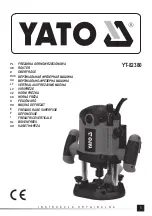
P964 APR Cable Sharing Gateway with 4-port Switch
F
Glossary
Cracker Tools
Programs used to break into computers. Cracker tools are widely
distributed on the Internet. They include password crackers, Trojans, viruses, war-dialers, and
worms.
Cracking
The act of breaking into computers or cracking encryptions.
Crossover Ethernet
cable
A cable that wires a pin to its opposite pin, for example, RX+ is wired to TX+. This cable
connects two similar devices, for example, two data terminal equipment (DTE) or data
communications equipment (DCE) devices.
Cryptoanalysis
The act of analyzing (or breaking into) secure documents or systems that are protected with
encryption.
CSU/DSU
Channel Service Unit/Data Service Unit. CSUs (channel service units) and DSUs (data service
units) are actually two separate devices, but they are used in conjunction and often combined into
the same box. The devices are part of the hardware you need to connect computer equipment to
digital transmission lines. The Channel Service Unit device connects with the digital
communication line and provides a termination for the digital signal. The Data Service Unit
device, sometimes called a digital service unit, is the hardware component you need to transmit
digital data over the hardware channel. The device converts signals from bridges, routers, and
multiplexors into the bipolar digital signals used by the digital lines. Multiplexors mix voice
signals and data on the same line.
DCE
Data Communications Equipment is typically a modem or other type of communication device.
The DCE sits between the DTE (data terminal equipment) and a transmission circuit such as a
phone line.
Decryption
The act of restoring an encrypted file to its original state.
Denial of Service
Act of preventing customers, users, clients or other machines from
accessing data on a computer. This is usually accomplished by interrupting or overwhelming the
computer with bad or excessive information requests.
DHCP
Dynamic Host Configuration Protocol automatically assigns IP addresses to clients when they
log on. DHCP centralizes IP address management on central computers that run the DHCP server
program. DHCP leases addresses for a period of time which means that addresses are made
available to assign to other systems.
Digital Signature
Digital code that authenticates whomever signed the document or software. Software, messages,
Email, and other electronic documents can be signed electronically so that they cannot be altered
by anyone else. If someone alters a signed document, the signature is no longer valid. Digital
signatures are created when someone generates a hash from a message, then encrypts and sends
both the hash and the message to the intended recipient. The recipient decrypts the hash and
original message, makes a new hash on the message itself, and compares the new hash with the
old one. If the hashes are the same, the recipient knows that the message has not been changed.
Also see Public-key encryption.
DNS
Domain Name System. A database of domain names and their IP addresses. DNS is the primary
naming system for many distributed networks, including the Internet.
DOCSIS
Data over Cable Service Interface Specification. It is the dominating cable modem standard,
which defines technical specifications for both cable modem and CMTS.
Domain Name
The unique name that identifies an Internet site. Domain Names always have 2 or more parts,
separated by dots. The part on the left is the most specific, and the part on the right is the most
general.
Downstream
The data flowing from the CMTS to the cable modem.
Downstream
Frequency
The frequency used for transmitting data from the CMTS to the cable modem. Normally in the
42/65-850 MHz range depending on the actual cable plant capabilities.
DRAM
Dynamic RAM that stores information in capacitors that must be refreshed periodically.
DTE
Originally, the DTE (data terminal equipment) meant a dumb terminal or printer, but today it is a
computer, or a bridge or router that interconnects local area networks.
EMI
ElectroMagnetic Interference. The interference by electromagnetic signals that can cause reduced
data integrity and increased error rates on transmission channels.
Encryption
The act of substituting numbers and characters in a file so that the file is unreadable until it is
decrypted. Encryption is usually done using a mathematical formula that determines how the file
is decrypted.
Ethernet
A very common method of networking computers in a LAN. There are a number of adaptations
to the IEEE 802.3 Ethernet standard, including adaptations with data rates of 10 Mbits/sec and
100 Mbits/sec over coaxial cable, twisted-pair cable, and fiber-optic cable. The latest version of
Ethernet, Gigabit Ethernet, has a data rate of 1 Gbit/sec.
Events
These are network activities. Some activities are direct attacks on your system, while others
might be depending on the circumstances. Therefore, any activity, regardless of severity is called
an event. An event may or may not be a direct attack on your system.
FAQ
(Frequently Asked Questions) -- FAQs are documents that list and answer the most common
questions on a particular subject.








































